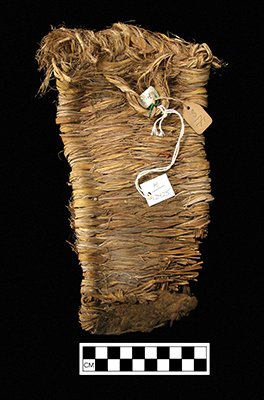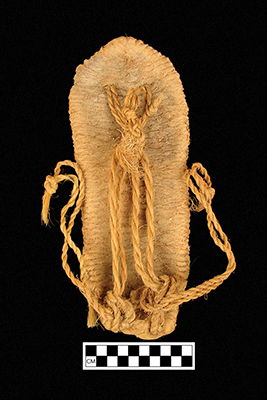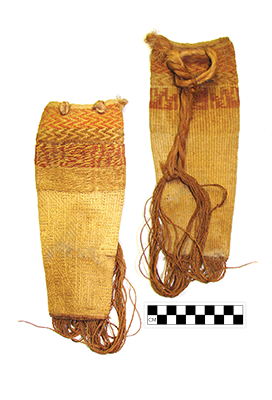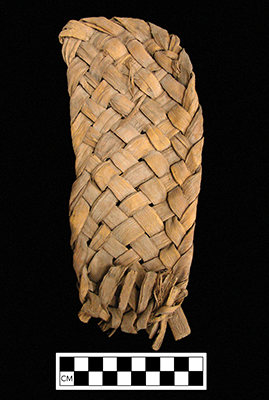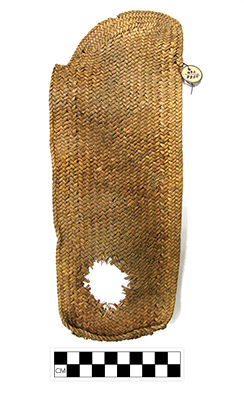History’s Footprints
The Museum of Indian Arts and Culture’s Stepping Out exhibition gives us occasion to examine the meaning‑packed relics of an anti‑barefoot movement
 Coarsely woven 2/1 braided yucca leaf sandal, cave in Magdalena Mountains, west-central New Mexico, ca. AD 900–1200. MIAC 43371/11a. Photograph courtesy of the Museum of Indian Arts and Culture.
Coarsely woven 2/1 braided yucca leaf sandal, cave in Magdalena Mountains, west-central New Mexico, ca. AD 900–1200. MIAC 43371/11a. Photograph courtesy of the Museum of Indian Arts and Culture.
BY LAURIE WEBSTER
Visit the storage facility of any Southwestern anthropology museum, and you’ll see drawer after drawer of pre-Hispanic woven sandals—a few in pristine condition, but most worn out from use. Their sheer quantities are astonishing because early Southwesterners didn’t actually need footwear. Human feet develop thick calluses to protect them from sharp objects and hot and cold temperatures, and for most of human history, people went around barefoot. Today our feet are tender because we wear shoes, but the use of footwear is essentially a cultural and sartorial choice in all but the most extreme climates.
Ancient sandals survive to a greater extent than most other woven items at archaeological sites because of their sturdy construction. Early Southwestern weavers fabricated their sandals from the leaves and fiber of yucca plants, and occasionally other materials, using the finger-weave techniques of plain weave, twining, braiding, and wrapping. Weavers equipped the sandals with toe or side ties to attach them to feet, and they sometimes padded the shoes with leaves or shredded bark to insulate them. Hide sandals and moccasins have also been found at some Southwestern archaeological sites, but they were never as popular as sandals until after about AD 1400, when sandals fell out of use and hide footwear replaced them. The impetus for this change was probably the growing interaction between settled, agricultural Pueblo groups and their Navajo, Apache, Pai, and Plains neighbors, and the increased importation of hides into these agricultural communities.
Just as we do today, early Southwestern groups used different styles of footwear and other types of clothing to express their social identities. During various time periods and in different regions of the Southwest, people furnished their sandals with distinctive toe and heel finishes, borders, and sometimes raised treads to distinguish them and their tracks from those of their neighbors. Low-visibility construction attributes provide information about cultural transmission and learning networks, while more visible decorative features express social group identities. Because of the temporal and regional diversity of sandals, they can be used like ceramics and projectile points to identify past cultural groups in the archaeological record.
Particular footwear styles were probably linked to wearers’ age, gender, ceremonial roles, or activities such as warfare, hunting, or long-distance trading. The archaeological record hints that men and women wore different sandal styles. Historically, Pueblo men and women have worn different styles of moccasins, so why wouldn’t their ancestors have worn different sandal styles in the pre-Hispanic past? Funerary data suggest that, during the early Basketmaker period, the coarse weft-faced wickerwork sandals and decorated twined sandals were worn primarily by men, and that women often used sandals with a different style of lacing. After about AD 700, people in the northern Southwest were rarely interred with footwear on their feet, making it difficult to link different sandal styles with gender. Perhaps future DNA studies can help address this question.
I first became interested in ancient sandals thirty years ago, when I began my studies of archaeological textile collections from the northern Southwest. Since then, I have become fascinated with the diversity of sandal styles and technologies. The earliest yucca sandals from the northern Southwest, used by Archaic hunter-gatherers, have been radiocarbon-dated to about 8,000 years ago. Two styles were worn: an open-twined sandal with the wefts worked in two-strand twining, and a warp-faced plain-weave sandal with multiple warps worked in an over-one, under-one weave. In twined and plain-weave sandals, the warp elements run lengthwise, and the weft elements cross and interact with the warps. Open-twined sandals faded from the archaeological record by about 5500 BC, but the warp-faced plain-weave style persisted into the Late Archaic period and may have evolved into the weft-faced plain-weave (wickerwork) sandals of the Basketmaker II period, which I discuss below.
Archaic hunter-gathers of the southern Southwest (southern Arizona and New Mexico, and the Trans-Pecos region of Texas) also wore plain-weave sandals, but they were different from those of the northern Southwest. Their sandals were weft-faced rather than warp-faced, and the earliest examples, dated to about 5,000 years ago, had only two warps. Later, four-warp and other multiple-warp varieties appeared in the region.
As Southwestern groups adopted maize agriculture and became more settled, their sandal styles became increasingly differentiated, and in some cases, more elaborate. Most of these sandals feature plain weave, twining, or braiding. In the following sections, I briefly review the historical development of these major styles and contrast the types people wore in the northern and southern Southwest.
Plain Weave Sandals
As noted, plain-weave sandals are one of the earliest forms of footwear on the Colorado Plateau. Thick, coarse, rigid, and easily manufactured, most were designed for rugged use. During the Basketmaker II period in the northern Southwest, weft-faced plain-weave wickerwork sandals with usually four, but sometimes five, six, or more warp elements fulfilled this role. Most have a warp and weft of whole yucca leaves, although juniper-bark and turkey-feather-cordage versions are also known. Stylistically, they have a square toe and heel, and many from northeastern Arizona and southeastern Utah have a toe fringe produced by extending the warp ends past the toe.
Around AD 650–700, a new style of plain-weave yucca sandal appeared in the northern Southwest. This coarse sandal had four to six warps, yucca leaf or fiber wefts, and a rounded or pointed toe, and it remained in use for about 400 years. A later variation has an elongated body that was folded up in back to cover the heel. The only two-warp style to gain popularity in the northern Southwest was a narrow sandal made of rigid, narrow leaf yucca wefts worked in a figure-eight weave, the ends shredded on the underside to make a pad, used after about AD 1000.
In the southern Southwest, the two-warp weft-faced plain-weave style of the Archaic period was used into late, pre-Hispanic times. Sometime around 200 BC, rigid plain-weave yucca sandals with four or more warps became popular in the Mogollon culture area of southwestern New Mexico. With a square toe and heel, these four-warp wickerwork sandals resemble the ones people in the northern Southwest wore, but they lack the toe fringe.
Several hundred years later, people in the Mogollon region created a more refined plain-weave sandal with fine cordage elements and a concentric warp. People along what is now the US–Mexico border of the southern Southwest adopted two variations of two- and four-warp wickerwork plain-weave sandals from the Trans-Pecos area: the scuffer-toe (a short sandal that covered just the ball of the foot), and a sandal with what is known as a fishtail heel. Some sandals incorporated both features.
Twined Sandals
The most finely woven, elaborate, and in my view, intriguing Southwestern sandals are the twined yucca cordage sandals of the northern Southwest. Closely linked to the Ancestral Pueblo culture of the Colorado Plateau, these sandals appeared in the Four Corners region in about 100 BC and persisted into the early-thirteenth century. Commonly referred to as twined sandals, most incorporate several weave structures, including twining, plain weave, and weft-wrapping.
The earliest versions are closely linked to the western variant of Basketmaker II culture. Most have square toes and heels, like the coarser plain-weave sandals of this period. Regional variations occur. The fanciest ones originated in southeastern Utah and northeastern Arizona, where the majority have a bolster or buckskin fringe at the toe; some have geometric or banded designs on the upper face; and most have horizontal ridges on the underside that served as a raised tread. The upper faces are woven primarily in plain weave (sometimes twining), and the raised tread was produced by a wrapped twining technique. Intriguingly, many have a row of human hair twining just below the buckskin fringe. People used human hair for a variety of weaving purposes during this period and, as documentation for the use of hair ties at historic Hopi sites shows, the choice of hair possibly was based on kin relationships.
Sometime around AD 300, the center of decorated twined sandal complexity shifted to northeastern Arizona, where it remained for several hundred years. During this time, twined sandals with slightly scalloped toes, colored geometric designs on the upper face, and raised, geometric designs on the soles appeared in this region. The apex of twined sandal production occurred in the Four Corners region between AD 600 and 750, when the most elaborate examples have a scalloped or rounded toe, a puckered heel, multiple zones of colored designs on the upper face, and highly complex geometric patterning on the sole. The production of these sandals was a technological feat. Some incorporate as many as fourteen weave structures, all variants of twining, plain weave, or weft-wrapping.
People in the northern Southwest continued to make twined sandals after AD 750, but they used simpler patterns and weave structures. Those sandals from between AD 1050 and 1150 tend to have simple bands or bold tapestry designs on the upper surface, and isolated, raised diamonds or triangles on the soles. By this time, the toes of the sandals were shaped for the right or left foot, and people began embellishing the toes with a small projection, or jog, along the outer edge. Some archaeologists have interpreted this jog as a symbolic sixth toe, an idea that Patricia Crown and colleagues corroborate in a recent American Antiquity article, which documents the presence of polydactyly, a congenital condition resulting in an extra finger or toe, among several high-status burials at Pueblo Bonito in Chaco Canyon. Significant assemblages of jog-toed, twined sandals have been recovered from Chaco, the West Ruin of Aztec, and Antelope House in Canyon del Muerto, and additional examples have been found at smaller sites in the Four Corners region that appear to have had links to Chaco. Their use may have signaled a symbolic connection to the Chaco leadership, religion, or political system.
The final iteration of twined sandals dates to the late-twelfth and early-thirteenth centuries. These sandals are coarser in texture than their predecessors, and have bold, raised designs on the soles produced by massive weft-wrapping. Around AD 1250, this long-lived and unique sandal tradition disappeared from the archaeological record. We still do not know whether these finely woven sandals served specific symbolic or ceremonial roles, or were simply a fancy form of footwear, but their elaborate iconography, evident labor investment, and demonstration of specialized technical knowledge suggest that they were something very special.
Braided (Plaited) Sandals
Braided sandals, also referred to as plaited sandals, were the last major sandal tradition to appear in the Southwest. Made from whole or split yucca leaves, most are woven in 1/1 (over one, under one), 2/1 (over two, under 1), or 2/2 (over two, under two) diagonal interlacing. Because the weave structures of the 2/1 and 2/2 braided sandals resemble those of twill-woven fabrics, they are often described as twill-plaited constructions.
In the northern Southwest, braided sandals appear earlier in the eastern portion of the Colorado Plateau than they do in the west. The presence of 2/2 twill-plaited sandals at the Durango Rock Shelters, a Basketmaker II site, led archaeologists to believe that they dated to that period, but a recent radiocarbon date from one sandal indicates that they were intrusive to the site, and actually date to late Basketmaker III. Additional radiocarbon dates from northwestern New Mexico support the appearance of 2/2 twill-plaited sandals in the upper San Juan River region between AD 600 and 700.
Braided sandals were well-established in the Four Corners region by the Pueblo I period. One style from southwestern Colorado and northwestern New Mexico was worked in fine 2/2 twill plaiting and had a square toe and cupped heel. Another early braided sandal, more common to southeastern Utah and northeastern Arizona, was coarsely woven in 1/1, 2/1, and less often 2/2 diagonal interlacing. It had a distinctive square heel made by vertically wrapping the lower ends of the braiding elements over a crosswise element and up to the surface. Many of these sandals were shaped for the right or left foot, suggesting manufacture after AD 900.
During the Pueblo II period, people in the Four Corners region of the Colorado Plateau began making finely woven 2/2 twill-plaited sandals with tapered toes and slightly cupped heels. By AD 1050–1100, many of these sandals, like their twined counterparts, were equipped with a toe jog. By the thirteenth century, 2/2 twill-plaited sandals and coarser 1/1 and 2/1 braided sandals were the most common footwear in the northern Southwest.
In the southern Southwest, coarse braided sandals appeared in the Mogollon region around AD 700 or slightly earlier. By AD 1000, they were ubiquitous south of the Mogollon Rim, outnumbering all other sandal styles. As in the north, the earliest examples have square toes and heels, and later ones have rounded toes and heels, often subtly shaped for the right or left foot. Most are woven of wide yucca leaves in 1/1 or 2/1 diagonal interlacing, and have the elements folded up at the heel and anchored with a transverse strip of yucca. These Mogollon sandals somewhat resemble the coarsely braided ones from the northern Southwest, but are made with thicker leaves and have a different heel finish.
Around AD 1300, a new style of braided yucca sandal, this one finely plaited and equipped with an H-shaped woven strap, appeared in the southern Southwest. This style is thought to be part of a widespread Salado sandal tradition related to the site of Paquimé (Casas Grandes) in northern Chihuahua, Mexico.
Despite their ubiquity at Mogollon and later Salado sites, braided sandals never achieved much importance in the Hohokam culture area of southern Arizona. There, coarse two-warp plain-weave sandals persisted from the Late Archaic period into late, pre-Hispanic times. People also wore a unique style of sandal shaped like a coiled braid. Made of yucca or agave fiber, these braidlike sandals appeared in southern Arizona around AD 800 and continued in use until about AD 1250–1300. Because of the poor preservation of textiles in the Hohokam region, most of these sandals are mineralized (petrified) or carbonized (charred) and difficult to analyze. The only unburned examples from southern Arizona come from Ventana Cave on the Tohono O’odham Reservation and Winchester Cave near Willcox. Their construction has been variously described as weft-wrapping (the site of Snaketown) and stitching on a matted fiber pad (Ventana Cave), but their technology is still open to question, and needs replication studies. In my opinion, most were probably made either by coiling a braided cord into the shape of a sole and then stitching the rows together, like Spanish espadrilles, or by twining the wefts in a spiral pattern over warps perpendicular to the long axis.
Archaeologists know a lot about Southwestern sandal styles, their construction, and how they changed through time, but they have barely scratched the surface in their understanding of sandal production and the social contexts in which sandals were used. If any Southwestern sandal tradition served a specialized purpose, it was probably the finely woven and ornate twined sandals of the Colorado Plateau. Their technological complexity and rich iconography raise a multitude of questions about who wove and wore them, whether certain villages specialized in their production, how and when people used this footwear, and what social messages they were intended to convey. All of these queries apply to other sandal styles, as well. These and many other intriguing questions invite future exploration.
Laurie Webster is an anthropologist who specializes in the textiles and other perishable material culture of the American Southwest. She lives in Mancos, Colorado.


